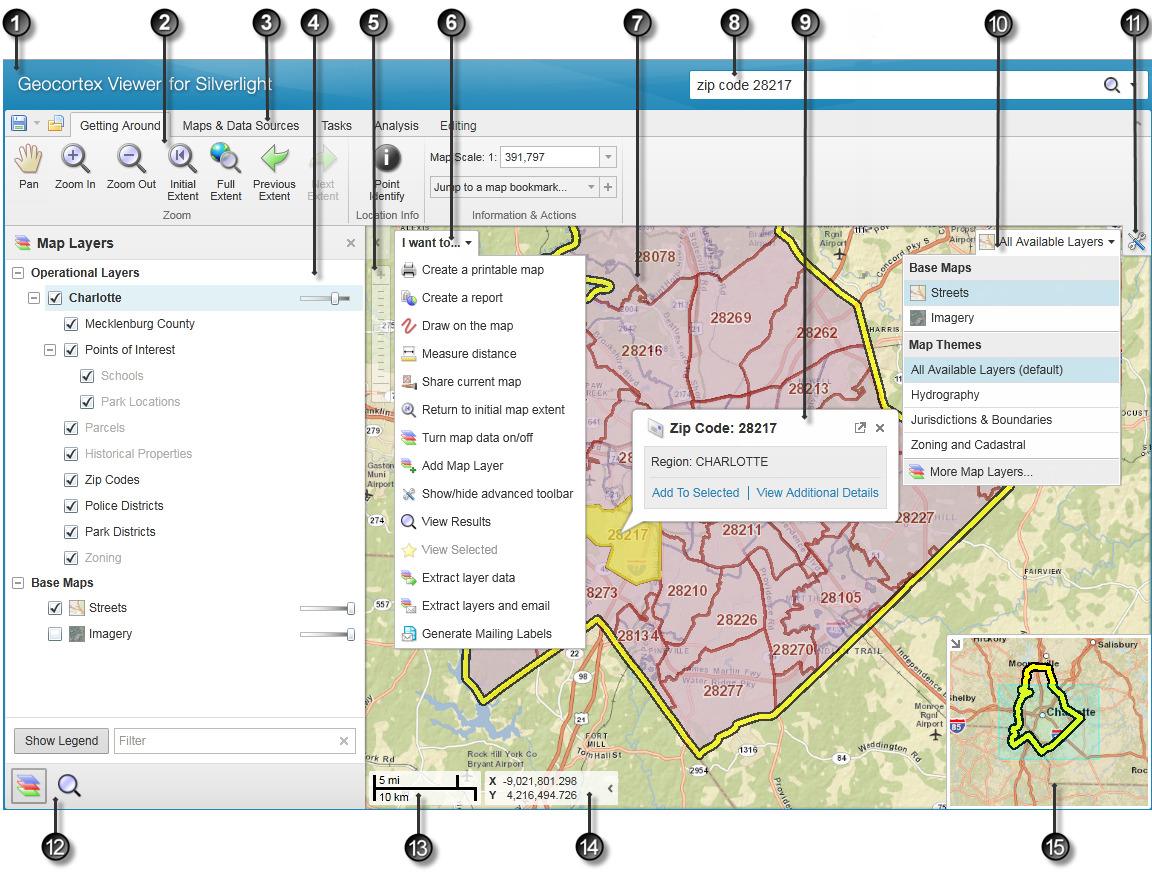
When you open the Viewer, you see a screen similar to the one below. Different versions of the Viewer may contain a different map and some extra features, but it is likely to have most of the features described. In the example below, all the navigation elements like the toolbar, the information panel, the I Want To menu and the overview map are visible so that they can be described. Normally, at least some of these elements would be hidden.

Navigation features in the main screen of the Viewer
| Number | Screen Element |
|---|---|
|
|
Viewer title bar: Displays the title of the application. |
|
|
Toolbar: The toolbar contains numerous tools that are grouped into tabs by function. |
|
|
Toolbar tabs: The toolbar consists of tabs that categorize the tools into high-level groups: Getting Around, Maps and Data Sources, Tasks, and Analysis. |
|
|
Information Panel: This panel lists information different kinds of information when you interact with the map. For example, it displays Map Layers where you can select different layers to hide or show on the map or it displays a list of map features in the Results List when you perform a search or use the Identify tool. The filter and icons at the bottom of the panel allow you to control what information to display in the panel. |

|
Zoom Slider: Use this slider to zoom in or out on the map by clicking the + or - or by dragging the marker up and down. |

|
I want to Menu: A menu of shortcuts to frequently-used tools. This menu tries to anticipate what you will want to do most often. |

|
Map: The map window where you interact with the map by zooming, panning, annotating, or right-clicking to get more information. |

|
Search Box: You can type in the name of a feature to search for it on the map. It is also possible to search map services. |

|
Map Tip: Map tips appear when you click on a feature listed in the Results List, or use one of the Identify tools. To find more information about the feature in the map tip, you can click View Additional Details. Click Add To Selected to add this feature to the Selected list. You can then find the feature later by clicking the Selected icon |

|
Base Map and Map Theme Menu: This menu lists the Base Maps and any Layer Themes if these are present. The menu allows you to select different combinations of Base Maps and Layer Themes. |

|
Toolbar Icon: Shows or hides the toolbar when clicked. |

|
Information PanelToolbar: Contains icons and a filter that you can use to control the information listed in the Information Panel. Clicking different icons changes the information to Map Layers, Results and any other options configured for the map. The Information Panel opens when you click the Show Layers button or when you run a search. To open it manually, click the arrow to the left of the I Want To menu.
The Show Layers/Show Legend button allows you to toggle between the map legend and the map layers in the panel. The legend only displays symbols for the layers that are active on the map. The legend items change with the scale of the map. |

|
Scale: The current scale of the map. |

|
Mouse Position: The position (coordinates) of the computer cursor on the current map. To hide the mouse position, click the small arrow on the right. |

|
Overview Map: Displays a thumbnail of the whole map with the current view shown as a small square on the map. The Overview map is an orientation tool to identify which part of the overall map you are currently zoomed in to. To hide the Overview map, click the arrow in the top left corner. |